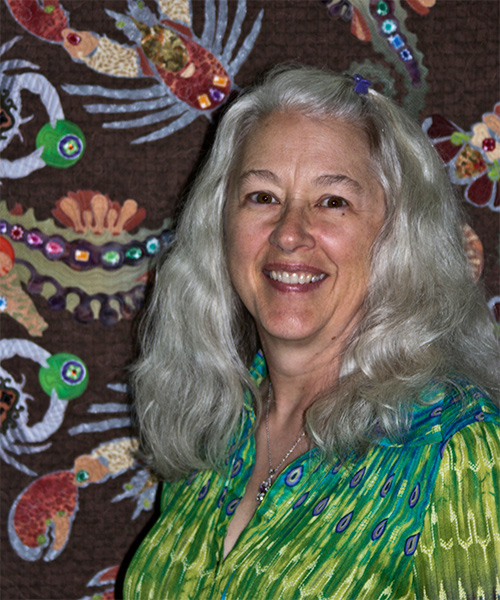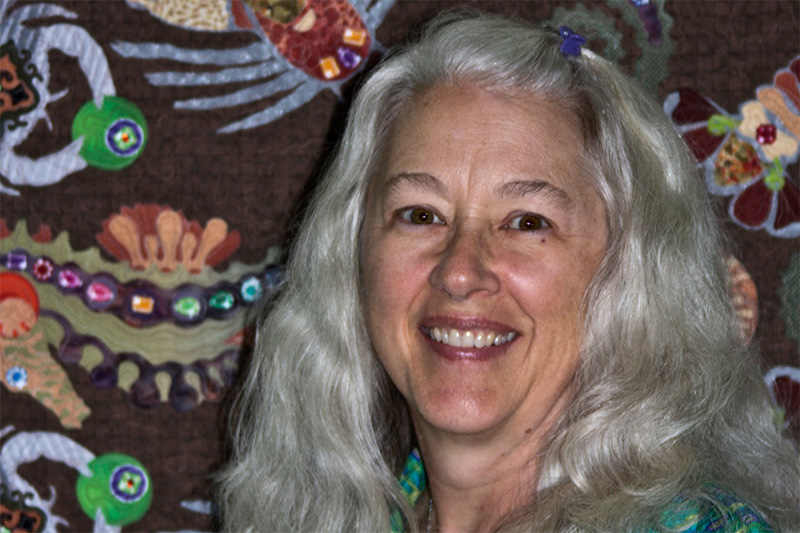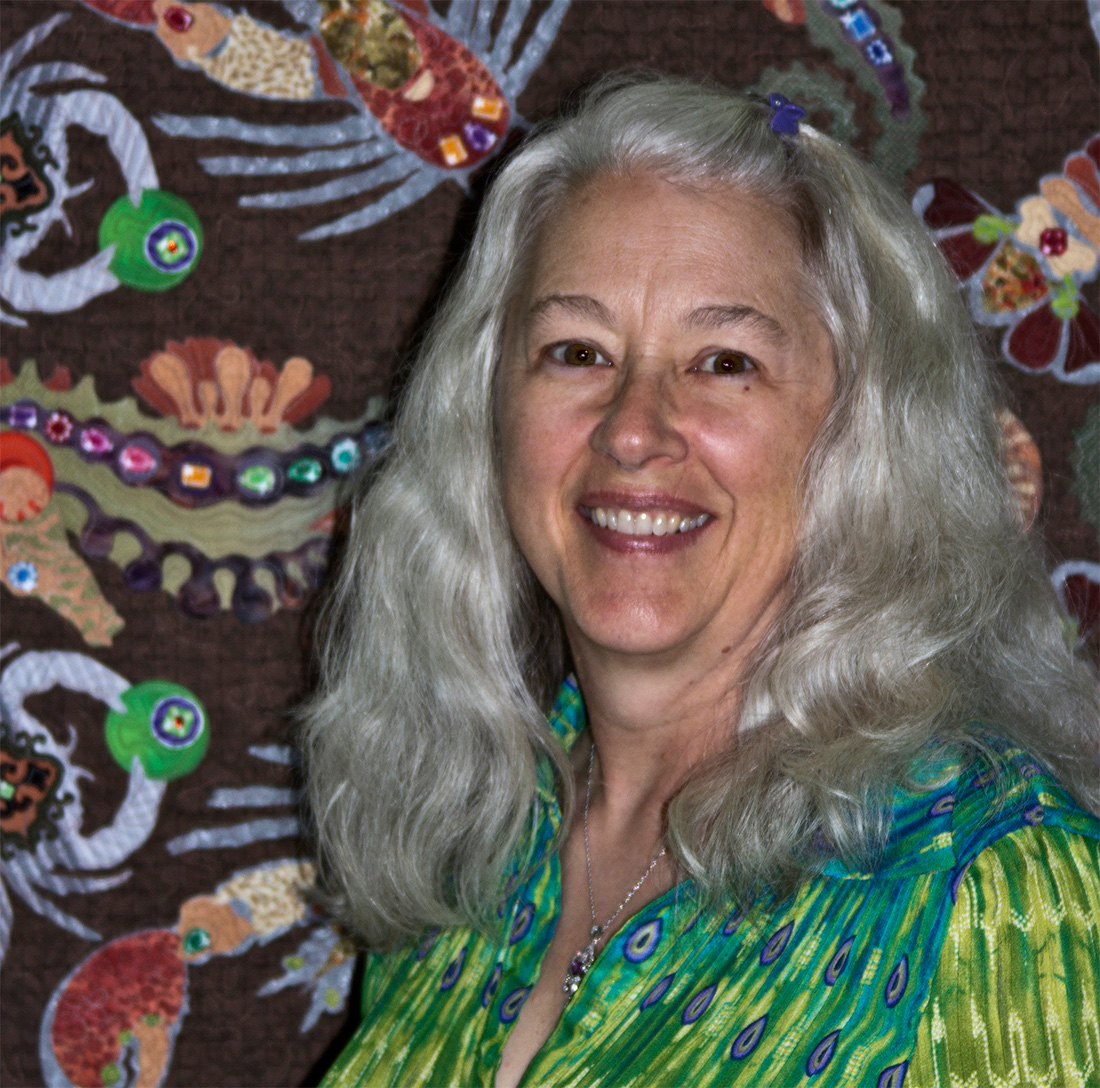


Biographical Statement
Deb Snider was born in Detroit when it was a thriving metropolis and Motown ruled the airwaves. She has enjoyed an adventurous career that has included teaching visual art to all age levels; being an arts administrator, exhibitions curator, and events manager; overseeing diverse programs for communities and schools; and working in retail marketing and banking. She has lived in Michigan, Florida, Colorado, Oregon, Utah, and Washington State, and loves both the water and mountains.
Deb now gets to pursue her passion for making art, including art quilts, drawings, and mixed-media collages. She loves to travel, read, hike, sing, dance, learn new skills, and spend time with friends and family. She is inspired by new combinations of words that form an idea for a new piece of artwork; random encounters with unique art materials and art forms; and by meaningful conversations with strangers. She falls in love with other’s ideas and has aesthetic moments at least a dozen times a day.
Artist Statement
Often, I think in mandalas and fans, enjoying both the symmetry and meditative aspects of round, repetitive motifs. These designs are present in numerous cultures; my influences are from Buddhist and Celtic earth-based paths. My artwork takes the form of art quilts, drawings, and mixed-media collages. I favor graceful curvilinear lines and shapes, and fine detail. My commitment is to use my artistic skills to benefit others. Each piece of artwork has at its core a message and story: about women, beauty, the environment, justice, social issues, or humanitarian concerns.
I intend to do my part to improve the world through sharing the abundance of my sales, supporting the causes and organizations in which I believe. When an original artwork is sold, I donate 20% of the net proceeds to the organization(s) that inspired the work, or whose story is told in the work. Favorite non-profits include Amnesty International, Care’s Women’s Empowerment Programs, the Climate Reality Project, Dove’s Campaign for Real Beauty, Heifer International, Save the Bees, and the Ocean Conservancy.
Frequently Asked Questions
How is an artwork meant to be displayed?
My art quilts, drawings, and mixed-media collages are hung directly on a wall. Art quilts have a 4” sleeve on the back that accommodates a slat. The slat has holes drilled in each end for headed nails that secure the art quilt to the wall, without the slat being visible. A slat is provided for each art quilt; however, the collector may opt for a more decorative rod/slat that is meant to be seen beyond the edges of the quilt at her/his own expense. My drawings and mixed-media collages are framed, covered with Plexiglas, and wired for hanging. I recommend using two headed nails on which to hang the wire, so the artwork is not subject to swinging on a wall; nails are placed closer for small artworks and further apart for large artworks.
Does an art quilt need to be framed?
No. However, if it is installed in a public area it can be shadow-box framed and covered with glass or acrylic for protection of the art quilt from dust, lint, and human touch.
How do I clean an artwork?
For an art quilt, all that is needed is an occasional, gentle sweep with a lint pick-up roller or damp cloth. If it becomes soiled, have it professionally cleaned. Avoid touching the art quilt to prevent oils or dirt from your skin being transferred to the artwork.
For drawings and collages, the frame and Plexiglas can be carefully cleaned with a glass cleaner and a microfiber cloth, to avoid scratching the Plexiglas.
Will an art quilt, drawing, or mixed-media collage fade over time?
Not if it is kept out of direct sunlight. Any artwork will fade under these conditions, which are never recommended.
Do you accept commissions?
No, sorry.
How long does it take you to make an art quilt, drawing, or mixed-media collage?
Depending on the size of the art quilt, it can take 200-500 hours. This time commitment may be condensed into days, weeks, or extend into months of work. Making an art quilt involves coming up with a concept; drawing a “cartoon” (full-scale preparatory drawing) so that various shapes can be cut and used as paper patterns; searching my fabric stash or acquiring new fabrics, embellishments, or other materials; preparing chosen fabrics with a fusible web; cutting, positioning, and ironing the pieces into place; machine quilting the layers; hand-sewing embellishments; sewing on a label; attaching a binding and sleeve; cutting, sanding and drilling the slat; and documenting the title, materials used, and price.
Drawings and mixed-media collages, depending on their complexity, can take 100-250 hours. They require the same intention and thoughtfulness as my art quilts, but are created from drawing and painting materials, papers, fabrics, archival adhesives, and other miscellaneous art supplies. I often work in series. I enjoy “fussy cutting” the collage elements and creating detailed drawn components. I easily get lost in the “flow” of making art. My artwork is my joy, my meditation, and my therapy!
How do you come up with your ideas for artworks?
Sometimes, it’s overhearing a phrase from another’s conversation; sometimes, it’s lyrics from a song or a line of a poem; sometimes, it’s inspiration derived from a single motif on fabric or paper; sometimes, it’s totally random.
I often work in series where I become hyper-alert to purchasing materials that continue the theme. Sometimes, I become obsessed with a social justice issue, or specific humanitarian or conservation organizations. The Muse can deliver new ideas at any time and in any place. I love Aha! Moments, and hope I always have a way to capture the idea on paper or phone!
How do you price your work?
Some artists base their pricing structures on the size of an art quilt, either by square inch or square foot. Pricing represents the artist’s best calculation of the cost of materials and the time invested in the artwork, as well as the relative reputation and “fame” of the artist. Artists must factor in commissions to galleries or agents who help to market the artwork. Artists who sell their work in galleries, art festivals, and on-line must be aware that once marketed on a website (which has global reach), they should not manipulate their prices based on regional norms. I do not alter my pricing based on more expensive markets, the venues in which they are seen, or the amount of commission charged by the gallerist or festival coordinator. Prices as noted on this website remain constant, whether they are purchased directly from the artist, at an art festival, or through a gallery.
Because giclée prints are available in multiples, their price point is much lower than an original artwork. I sometimes add original components to a giclée.
Is your work under copyright?
Yes. I retain copyright of my artwork images at all times, even after the artwork is sold to a collector. I may use images of my work for the printing of cards, calendars, or in books and magazines. Collectors of my work may not use my images for their own financial gain. I may license my images to others for business purposes.
Purchasing Artwork
If you wish to purchase my artwork, please contact me at debsniderart@gmail.com. Shipping charges will be added to the price.
Care of Artwork and Retention of Copyright
Care of an Original Artwork (Art Quilts):
The artist has predominately used premium cotton fabrics and Omni threads from Superior Threads of St. George, Utah; however, other fabrics, trims, laces, threads and beads may also be used. This is a raw-edge fabric collage that is quilted by machine and finished by hand. The hanging slat is provided, with two holes at the ends so that the art quilt can be hung with two headed nails. For minor cleaning/dusting, please use a lint roller or damp cloth. This art quilt should not be installed where it will receive direct sunlight or unfiltered fluorescent light. The artist cannot guarantee against fading or damage over time if the artwork is not cared for properly. The artist reserves permanent copyright of the image of each artwork.
Care of an Original Artwork (Drawings & Mixed-Media Collages):
The artist has used, where possible, archival materials in the creation of this artwork. This includes, but is not limited to, drawing/painting materials, papers, adhesives, matting and framing. Plexiglas is used in lieu of glass because of its ultraviolet protection and impact tolerance; however, it is easily scratched. Artwork should not be installed where it will receive direct sunlight or unfiltered fluorescent light. It should also not be exposed to humid or moist environments. The artist cannot guarantee against fading or damage over time if the artwork is not cared for properly. The artist reserves permanent copyright of the image of the artwork.
Care of Giclée Prints (Archival Copies):
A giclée is an “edition” (series) of an image that can be limited in number or unlimited; this determination is made by the artist. Archival ink is used in making each copy. The artist may choose to add collaged elements to the giclée. A collector may choose to purchase my giclées unframed or framed; these have different price points. If the collector wants to select her/his own matting and framing, I recommend Plexiglas in lieu of glass because of its ultraviolet protection and impact tolerance; however, it is easily scratched. Artwork should not be installed where it will receive direct sunlight or unfiltered fluorescent light. It should also not be exposed to humid or moist environments. The artist cannot guarantee against fading or damage over time if the artwork is not cared for properly. The artist reserves permanent copyright of the image of the artwork.